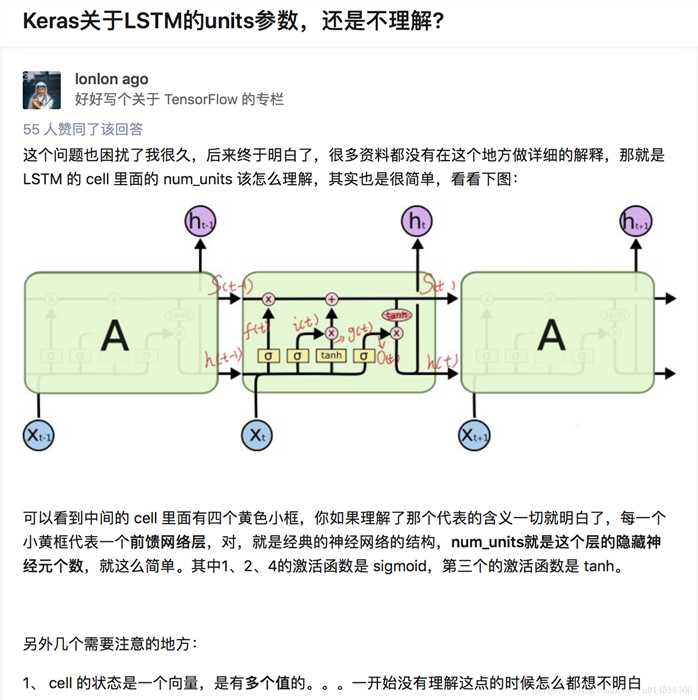关于tensorflow里面的tf.contrib.rnn.BasicLSTMCell 中num_units参数问题
Posted cupleo
tags:
篇首语:本文由小常识网(cha138.com)小编为大家整理,主要介绍了关于tensorflow里面的tf.contrib.rnn.BasicLSTMCell 中num_units参数问题相关的知识,希望对你有一定的参考价值。
这里的num_units参数并不是指这一层油多少个相互独立的时序lstm,而是lstm单元内部的几个门的参数,这几个门其实内部是一个神经网络,答案来自知乎:

class TRNNConfig(object): """RNN配置参数""" # 模型参数 embedding_dim = 100 # 词向量维度 seq_length = 100 # 序列长度 num_classes = 2 # 类别数 vocab_size = 10000 # 词汇表达小 num_layers= 2 # 隐藏层层数 hidden_dim = 128 # 隐藏层神经元 rnn = ‘lstm‘ # lstm 或 gru dropout_keep_prob = 0.8 # dropout保留比例 learning_rate = 1e-3 # 学习率 batch_size = 128 # 每批训练大小 num_epochs = 5 # 总迭代轮次 print_per_batch = 20 # 每多少轮输出一次结果 save_per_batch = 10 # 每多少轮存入tensorboard class TextRNN(object): """文本分类,RNN模型""" def __init__(self, config): self.config = config # 三个待输入的数据 self.input_x = tf.placeholder(tf.int32, [None, self.config.seq_length], name=‘input_x‘) self.input_y = tf.placeholder(tf.float32, [None, self.config.num_classes], name=‘input_y‘) self.keep_prob = tf.placeholder(tf.float32, name=‘keep_prob‘) self.rnn() def rnn(self): """rnn模型""" def lstm_cell(): # lstm核 return tf.contrib.rnn.BasicLSTMCell(self.config.hidden_dim, state_is_tuple=True) def gru_cell(): # gru核 return tf.contrib.rnn.GRUCell(self.config.hidden_dim) def dropout(): # 为每一个rnn核后面加一个dropout层 if (self.config.rnn == ‘lstm‘): cell = lstm_cell() else: cell = gru_cell() return tf.contrib.rnn.DropoutWrapper(cell, output_keep_prob=self.keep_prob) # 词向量映射 with tf.device(‘/cpu:0‘): embedding = tf.get_variable(‘embedding‘, [self.config.vocab_size, self.config.embedding_dim]) embedding_inputs = tf.nn.embedding_lookup(embedding, self.input_x) with tf.name_scope("rnn"): # 多层rnn网络 cells = [dropout() for _ in range(self.config.num_layers)] rnn_cell = tf.contrib.rnn.MultiRNNCell(cells, state_is_tuple=True) _outputs, _ = tf.nn.dynamic_rnn(cell=rnn_cell, inputs=embedding_inputs, dtype=tf.float32) last = _outputs[:, -1, :] # 取最后一个时序输出作为结果 # last = _outputs # 取最后一个时序输出作为结果 with tf.name_scope("score"): # 全连接层,后面接dropout以及relu激活 fc = tf.layers.dense(last, self.config.hidden_dim, name=‘fc1‘) fc = tf.contrib.layers.dropout(fc, self.keep_prob) fc = tf.nn.relu(fc) # 分类器 self.logits = tf.layers.dense(fc, self.config.num_classes, name=‘fc2‘) self.y_pred_cls = tf.argmax(tf.nn.softmax(self.logits), 1) # 预测类别 with tf.name_scope("optimize"): # 损失函数,交叉熵 cross_entropy = tf.nn.softmax_cross_entropy_with_logits(logits=self.logits, labels=self.input_y) self.loss = tf.reduce_mean(cross_entropy) # 优化器 self.optim = tf.train.AdamOptimizer(learning_rate=self.config.learning_rate).minimize(self.loss) with tf.name_scope("accuracy"): # 准确率 correct_pred = tf.equal(tf.argmax(self.input_y, 1), self.y_pred_cls) self.acc = tf.reduce_mean(tf.cast(correct_pred, tf.float32))
以上是关于关于tensorflow里面的tf.contrib.rnn.BasicLSTMCell 中num_units参数问题的主要内容,如果未能解决你的问题,请参考以下文章